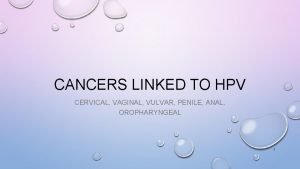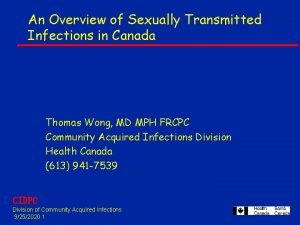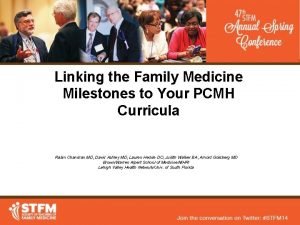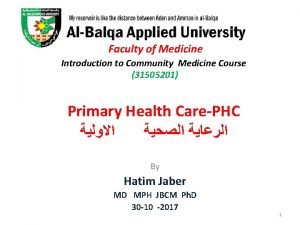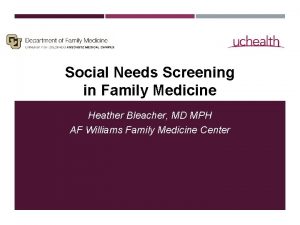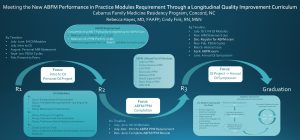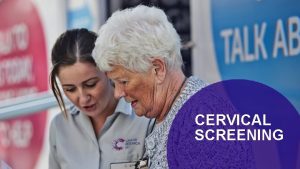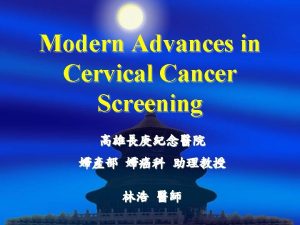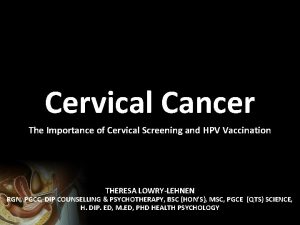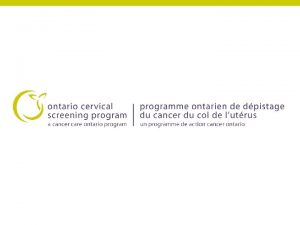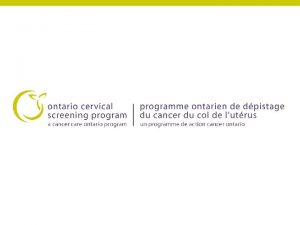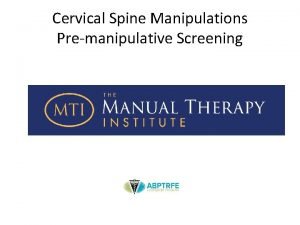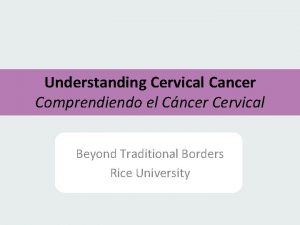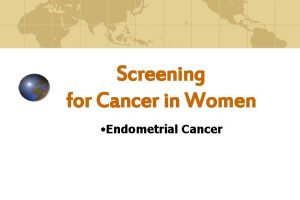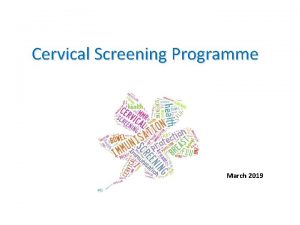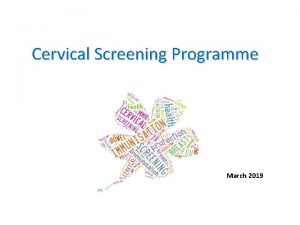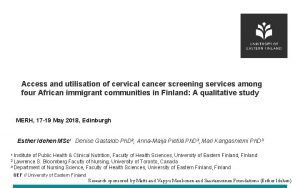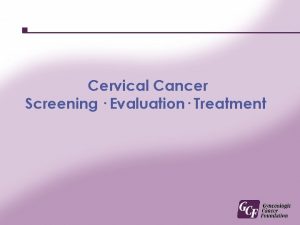Cervical Cancer Screening Compliance at a Family Medicine






















- Slides: 22

Cervical Cancer Screening Compliance at a Family Medicine Residency Office Christopher Shelby, M. D. Julie Kinsman, M. D. Spartanburg Family Medicine Residency April 29, 2006

Background § Quality of care is becoming increasingly important in the care of patients and for physician reimbursement § Managed care plans grade physicians based on their performance of adhering to guidelines § Physician documentation of adherence to guidelines is a necessity

NCQA HEDIS § National Committee for Quality Assurance (NCQA) Health Plan Employer Data and Information Set (HEDIS) Criteria is used at Spartanburg Regional to evaluate physician adherence to quality of care measures § These measures were designed to allow comparison of managed health care plans performance and adherence to standardized criteria

HEDIS Criteria for Cervical Cancer Screening § HEDIS requires pap smear screening for every female ages 21 to 64 at least once in the previous two years, unless a hysterectomy is noted in the chart § HEDIS goals are set at 80 % compliance as of year 2000 guidelines

Why We Do Pap Smears § Half of all women newly diagnosed with cervical cancer have not had a Pap test in the past 5 years § Fifteen percent of women with cervical cancer develop it before the age of 30 § The cervical cancer rate for all U. S. women is about 8 per 100, 000, highest in Vietnamese, Hispanic, Korean, and Alaskan Americans § http: //www. ncqa. org/somc 2001/CERVICAL/SOMC_2001_CERVICAL. html

Why We Do Pap Smears § An average 20 year old woman can reduce her lifetime risk of cervical cancer from 2. 5% to 0. 7% through regular screening § The cervical cancer cure rate approaches 100% if the patient is treated when the cancer is in an early stage § http: //www. ncqa. org/somc 2001/CERVICAL/SOMC_2001_CERVICAL. html

Objective § Demonstrate that educational intervention and a reminder system can improve physician performance in adhering to HEDIS criteria regarding cervical cancer screening

Methods § Selected population at Spartanburg Regional FMC of 21 to 64 year old females seen during a six month period from June to December 2004 and then again from July 2005 to January 2006 § Using a random number generator, 291 and 292 charts respectively were selected to review

Abstracted Chart Data § Reviewed charts for : § Medical record number § Date of birth § Race § Pap done in clinic or by different provider § Pap offered § Hysterectomy (excluded) § Number of visits if two or less (excluded)

Intervention § Group discussion at Resident’s Conference regarding guidelines for cervical cancer screening and reminder regarding proper documentation § Implementation of reminder system in Centricity Electronic Medical Records § Index card reminder placed on each resident work station

Total Number of Charts Prior to Intervention

Total Number of Charts After Intervention

Paps Performed by Age Prior to Intervention

Paps Performed by Age After Intervention

Paps Performed by Race Prior to Intervention

Paps Performed by Race After Intervention

Location of Paps Done Prior to Intervention

Location of Paps After Intervention

Results After Intervention § Intervention improved screening in all age groups, (66% to 82% < age 40 and 46% to 61% > or = age 40) § Intervention improved screening in Caucasian population (45% vs. 71%) and African American population (59% vs. 72%) § More people were screened in our clinic (51% vs. 61%), more paps were documented as done elsewhere (6% vs. 10%) and more refused paps were documented (7% vs. 14%)

Comparison Chart

Results After Intervention § Intervention improved overall compliance from 57% to 71% § Counting those patients who were offered cervical screening, but was refused or not yet performed, this increased to 85%

Conclusion § Educational intervention and a reminder system improved compliance for cervical cancer screening in this setting
 National breast and cervical cancer early detection program
National breast and cervical cancer early detection program National breast and cervical cancer early detection program
National breast and cervical cancer early detection program Stage 4 cervical cancer
Stage 4 cervical cancer Hpv cervical cancer
Hpv cervical cancer Hpv cervical cancer
Hpv cervical cancer Cervical cancer hcp
Cervical cancer hcp Lung cancer screening shared decision making tool
Lung cancer screening shared decision making tool Types of family in community medicine
Types of family in community medicine Principles of family medicine
Principles of family medicine Halifax family medicine residency
Halifax family medicine residency Meritus family medicine residency
Meritus family medicine residency Family medicine procedures
Family medicine procedures Milestones family medicine
Milestones family medicine Janalynn beste md
Janalynn beste md Types of family in community medicine
Types of family in community medicine Define family practice
Define family practice Pediatric shelf percentiles
Pediatric shelf percentiles Ecomap example
Ecomap example St cloud family medicine residency
St cloud family medicine residency Af williams family medicine center
Af williams family medicine center Kaiser san diego family medicine residency
Kaiser san diego family medicine residency Family medicine in ethiopia
Family medicine in ethiopia Cabarrus family medicine concord
Cabarrus family medicine concord



